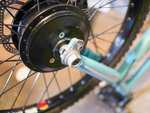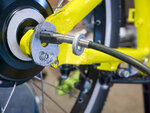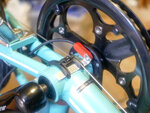indianajo
Well-Known Member
It's not that hard. If you can crimp a terminal on a wire using a pro tool like a klein, 4 hours on the no-display models. 90 minutes of that making the torque arms and clamps if you didn't buy them. Have an angle grinder & safety glasses available if the axle slot is too small.However, the installation time is usually underestimated, and the level of customization needed if a bike is not a 'perfect ' fit is often always missed by a first timer, and even some of the pro's.
It's going to be a royal pain for most, as a surprising number of people tend to overestimate their mechanical or electrical skills. Just ask any spouse of a DIY homeowner how their originally planned project times in reality doubled, tripled, or worse.
Hard part is making cheap hubs not lock up under the pressure of the dropout.
I agree, rim brakes are obsolete in a disk brake world, if you ride in the rain or snow. I do. That conversion is not impossible either, just making a few U-clamps out of metal scrap. Buying mating cables is the hard part on that, I still don't have a name for the end I use. No vendors use a name either.




